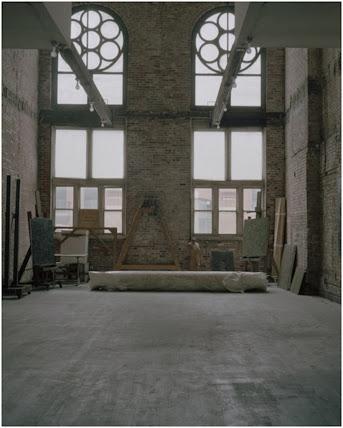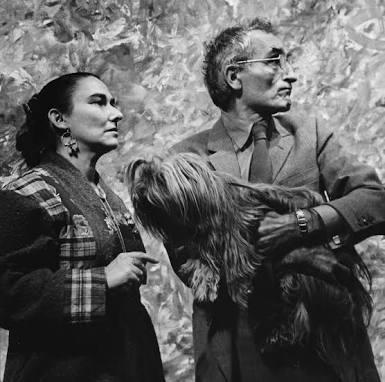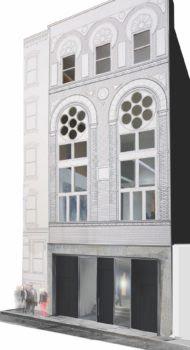Back in the year when Expressionist painters Milton Resnick and Pat Passlof were budding artists, they brought a small piece of land in Manhattan. In 1963 when they had brought this synagogue on the Lower East Side of Manhattan, on Forsyth Street, Passlof parents found it to be too tiny and had acknowledged it as a rat hole. They brought it for $20,000, she said, with a little help from her parents.
They were horrified, she said, by the condemned building, its floors collapsing, its windows gone, sold to them by a man who was storing bar equipment there. “But I couldn’t deny that,” Passlof once told an interviewer, detailing the extensive work that she undertook to make it habitable. Later in the years to come in 1976 Resnick moved to a close-by synagogue of his own, at 87 Eldridge Street. They two got acquainted and got married, living and working in those separate buildings for the rest of their lives. Resnick died in 2004 at the age of 87, Passlof in 2011 at 83.

The renovated building
Resnick loved creating large-scale, intricate, paint-heavy works while Passlof had a style of quick gestures, flowing lines, and waves of color. At that time city’s art galleries were congregated elsewhere, farther uptown or off to the west in SoHo. But when the Eldridge Street synagogue opens to the public in February 2018 after extensive renovations, as the exhibition space of the Milton Resnick and Pat Passlof Foundation, it will be at the center of a trendy gallery neighborhood.

The artist Milton Resnick

Pat Passlof
The exhibition space will host some 30 of Resnick’s pieces, around a dozen of which will be borrowed from private and museum collections, including New Bride (1963), a 210-inch-long canvas owned by the Smithsonian American Art Museum in Washington, D.C.Much of the work on the Eldridge Street building, which was funded by the sale of Passlof synagogue home.
It was devoted to installing climate control, a prerequisite for many lending institutions. Ryall Sheridan Architects handled the design, with special effort made toward preserving the look and feel of the building, which dates to around 1890 and was first a tenement.

The inside of the art centre
The idea for the foundation whose mission in part is to preserve the pair’s legacy, came very much from Passlof. “Resnick was an anti-careerist,” Kernan said. “He was focused only on his painting, getting up in the morning, going to the studio. He wasn’t particularly good at relating to dealers or museums. He tended to make enemies.” Though many of Resnick’s finest paintings are housed in museum collections, they are not often shown, said Geoffrey Dorfman, the foundation’s secretary, who has written a not-yet-published Resnick biography.
The organization’s goal according to him is to sidestep the museum hierarchy and do it themselves. The paintings will make the case for the quality of the artist’s work. Milton’s paintings are not incredibly photogenic. They don’t translate that well that they are dark and there’s no image. It’s something that has to be experienced.

The artist couple duo
As per the foundation’s mission, galleries on the first and fourth floors of the Eldridge Street space will be used to present rotating shows devoted to “mature” abstract painters. Kernan said that Passlof wanted to help older artists, who maybe had a career and were not being promoted at the moment who was not young and therefore were not attracting the attention of the art world. The second floor will be given over to displays of Resnick’s work.
There are some 350 canvases by the artist in the foundation’s holdings, as well as thousands of works on paper, though Dorfman noted that only around 40 of the paintings go way about to the year 1980, which make loans essential when aiming to display the whole of his work. The artist’s modestly sized final studio space has also been kept intact on the third floor, where the foundation’s offices will also be located, and they will be open by appointment.
The Resnick and Passlof Foundation joins a small number of artist studios that are open to the public in downtown Manhattan, a list that includes 101 Spring Street Donald Judd’s former home and workspace in SoHo, which opened in 2013, the Renee and Chaim Gross Foundation in the West Village and Edward Hopper’s studio which is on the Washington Square Park.
Discussing Resnick’s career, Dorfman noted that, while Resnick was one of the leading artists in the 1930s, and was close with Willem de Kooning, he left New York to serve in World War II and had his New York solo debut after many of his contemporaries. “Most of those people that he knew were dead by 1970,” Dorfman said. “When you think about Rothko and Newman and Jackson Pollock, Franz Kline, Hans Hofmann, none of them made it past 1970 except Bill” de Kooning. “So Milton begins as an Abstract-Expressionist, but he really reaches his maturity after Abstract Expressionism is no longer in the spotlight.”

New York Exhibition center
While living on the Lower East Side, Dorfman said, “Milton is kind of working in the shadows, and that’s where his most majestic work occurs. He’s somebody whose career is not coordinated with how the art world is moving. He’s a man who had developed his own world, really, within the confines of his studio.” If all goes according to plan on the remaining construction work, which is slated to wrap by the end of the year, the doors of that studio will soon be thrown open, revealing a major new arts institution.
Maintaining that space for posterity will require fund-raising from the public and private sources, Kernan noted. “That’s a daunting project,” he said, sounding rather undaunted. “It’s a little bit of a gamble that it’s all going to work, but we’re naïve enough to have started it and hope to see it through.”



What do you think?